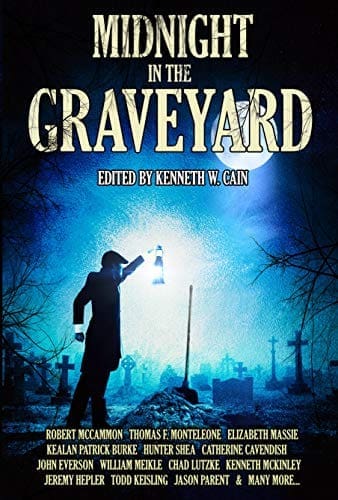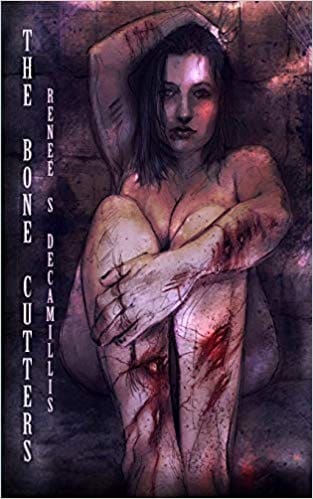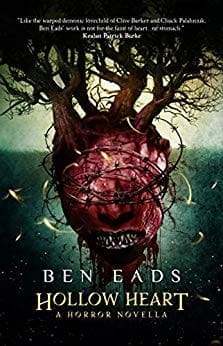It’s easy to fall into any of these stories, the writing is that good. The imagery driven stories overall have amazing reader/writing connectivity. A few of the stories didn’t hold my interest as much as the others, but there’s something for everyone in this collection. Some pass for urban legends, others are straight up creepy and just right for me, deliciously gory ones. There’s fan favorites: Robert McCammon, Elizabeth Massie, and Tom Monteleone, other established writers, and a few newbies. This Anthology of ghost stories shows a lot of promise for a newer publishing company.
My favorite stories:
“Dog Days” by Kenneth W. Cain is a collection of letters, scratches, and texts depicting ferocious dogs. I don’t want to give the story away, but it really spoke to me. I want others to love it just as much as I did. I have to admit that I have 3 large dogs. I also take guilty pleasure in watching fictious dogs attack people on tv and in movies. Seriously. I know, it’s twisted…but yeah dogs! Of course my own darlings would never…
“That b*st*rd got in and next thing I know, I’m on the floor grappling for my life. No way I can shake that image from my thoughts now. Every time I close my eyes, I see it standing over me, it’s jaws snapping again and again. It’s bloodshot eyes squinted. Lips drawn back in a snarl. Foam and spit and blood dripping onto my face.”
And:
“November 29th, 2009 (found September 4th, 2018 carved into the foyer closet wall) F*cking dogs! G*ddamned dogs! Kill. Kill. Kill. Dogs suck. Do”
“Russian Dollhouse” by Jason Parent depicts a haunted house with a few creepy surprises ala Saw. Each horrific room fits into the next gory little room like the Russian dolls of the title.
“Cemetery Man” by John Everson is a darkly funny story despite its gory little dip into necrophilia. It’s reminiscent of Italian Giallo films. Dario Argentio is a personal favorite.
“Kendra had her lips on the pale dark lips of the corpse. And as I realized this, I saw her arms reach around his shriveled back and pull his crypt-cold skin close to hers.
The dead guy made a sound like gravel in a grinder, and suddenly he stood up, and yanked Kendra with him. She squealed with surprise but didn’t escape his grasp as he pulled her into the coffin he’d vacated.”
While I’m still on a movies theme, “Ghost Blood” by Kelli Owen takes place at a Drive-In Theatre. The story itself reflects awesome grindhouse sensibility. Some people see ghosts, but Neil sees blood. Old blood, new blood, blood everywhere.
“Last Call at the Sudden Death Saloon” by Allen Leverone is seriously creepy. It wins my heart with a Sanitarium and the dreaded skinning of people (perhaps alive, one can only hope).
“Within a hundred yards of starting his walk he could swear he began to hear the gibbering of tortured spirits. They cackled and threatened, not in any understandable language but on a more elemental level.
Seth had read once that the producers of the movie, The Exorcist, had inserted audio of pigs being slaughtered ino the sound track at a volume too low to be consciously perceived but loud enough to cause unreasoning terror in the moviegoer’s brain. This felt like the same thing.”
“The Ring of Truth” by Tom Monteleone is wonderfully grisly work. The “ring” of the story holds the ears of victims during a time of war. It’s reminiscent of when the character Daryl Dixon goes native during an episode of “The Walking Dead.” Also, as one character is relating his experiences during the war, the ears seem to represent the telling of stories and who might be listening.
The quote in the beginning of “Portrait” by Kealan Patrick Burke sums up the story beautifully.
“I found I could say things with color and shapes that I couldn’t say any other way—things I had no words for.” Georgia O’Keefe.
The reason I say this is because this story feels like a painting. One done by Andrew Wyeth with its muted grey and bloody red landscapes of language—it’s a lullaby for death and mourning and rebirth. I really loved this story. I resisted at first because it was so quiet, and I’d grown use to the louder pieces of this Anthology. I’m glad I stuck with it. It’s haunting.
“One look at her face and the girl knew why.
She was blue, her eyes the color of rubies. Her tongue was black and poking from the side of her colorless lips as if she had died making a joke. There were odd marks on her neck, like snakes made of ash. The girl stood frozen upon the stair until her father looked up and roared at her to go to her room. His eyes were red too. She could tell he’d been crying. This scared her more than anything, more that the sight of her lifeless mother being hauled like a bag of coal out of the basement, so she had done as he’d demanded and retreated to her room.”
It’s a perfect ending to Midnight in the Graveyard.
Usually Anthologies are a mixed bag of okay, good, great, outstanding. That didn’t happen here. This Anthology shows off writers who give a damn. Not all the stories worked for me personally, but the ones that did really moved me. I looked over the Amazon reviews and I noticed a lot of love being given to the other stories I didn’t highlight. This goes to show that there’s something for everyone here.
















